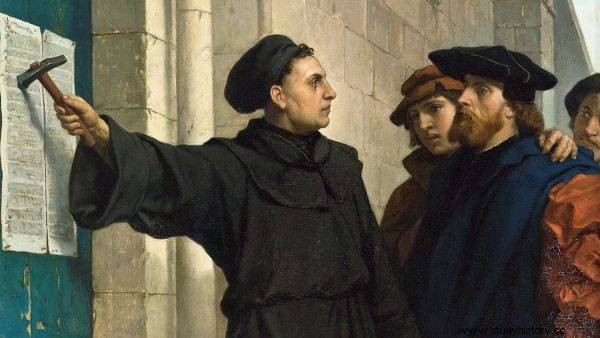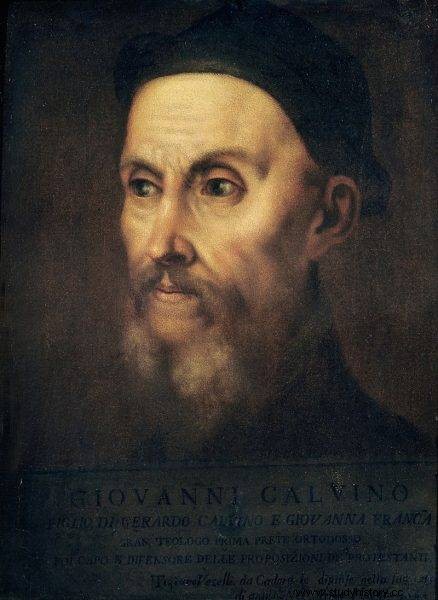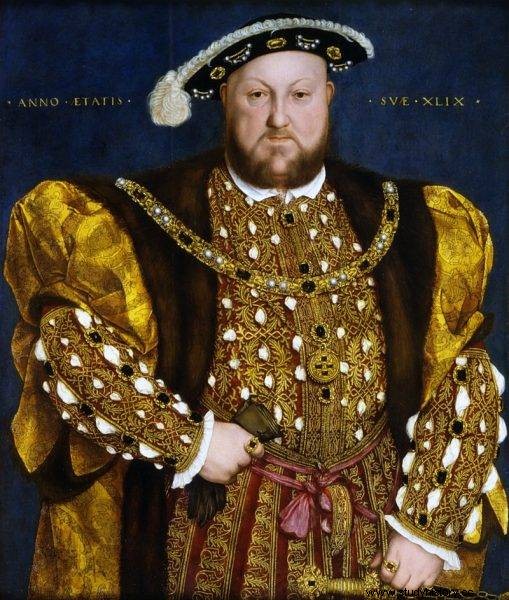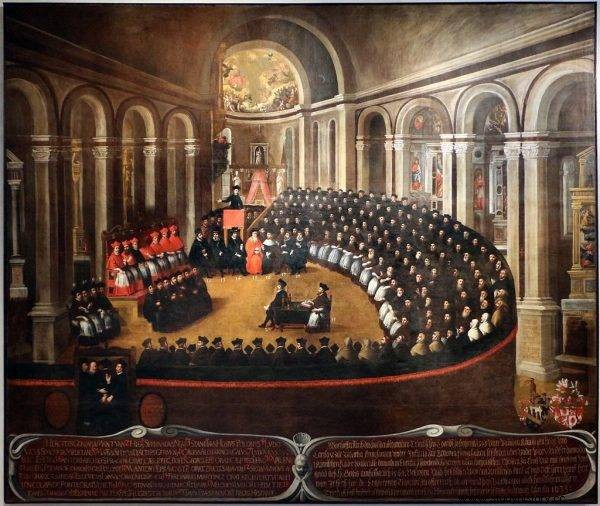The medieval Church often struggled with internal problems. The emperor's troublesome fight with the pope for investiture (i.e. for power in the Christian world) and lost crusades led to the loss of prestige. Many contemporary thinkers demanded significant changes. The vision of the approaching reform was inevitable ...
The moral corruption of the clergy and a peculiar loosening of discipline in the Church led to criticism of the behavior of priests and religious. They were accused of departing from the idea of poverty and humility, they were criticized for selling offices and church dignities (simony), supporting their relatives and securing high positions for them (nepotism), and breaking the principles of celibacy (Nicolaitanism).
Reasons for the split
The clergy led a secular way of life, ceasing to be an authority for the faithful. Popes and bishops waged wars and meddled with politics, which only exacerbated the problem. Just look at the biography of Saint Alexander VI.
Criticism also touched on the lack of involvement in pastoral activity; after all, so crucial for believers. Many clergymen took advantage of the money obtained from benefices (i.e., the lifetime right to receive income related to holding a certain church office) without even staying in their parishes. The effect was that had to be replaced by vicars in teaching and celebrating the liturgy. However, they usually had little theological education.
However, it was not only moral and social allegations that contributed to the demand for reform. The general rise of new humanistic attitudes has led to independence and critical thinking. Studying the biblical texts in the original languages aroused the desire to return to simplicity and complete compliance with the letter of the Holy Scriptures.

Erasmus of Rotterdam in the painting by Hans Holbein the Younger
The whole Church has not been corrupted by morals. Some monks and pious priests directed their teachings towards the primal, strict rule - the Bernardine monks, i.e. the fraction of the Franciscans, were very popular. The Renaissance tried to emphasize the individual approach of man to religion and the reception of the Gospel. The ignorance of the clergy, superstition and ignorance were attacked, and the idea of spiritual unity was favored. Erasmus of Rotterdam wrote about the shortcomings of the clergy:
(...) These people, who colloquially call monks and monks - names in both cases completely false, since a large part of them is as far away as possible from keeping the law, and monks - that is, loners - they are not at all, since they are encountered everywhere (...).
They don't smell so completely that they can't even read. When they continue to bellow their psalms with donkey voices in the churches - at least at an appropriate rhythm, but without any understanding - they believe that this is the highest delight for the heavenly ears (...). And in this way, by their sloppiness, ignorance, simplicity and insolence, these nice ladies give us - as they say - "the example of the apostles".
Martin Luther and his theses
Proposals for reforms in the liturgy and church organization had been submitted earlier. In the Middle Ages, proposers were considered heretics, such as Jan Hus and John Wycliffe. The split in the Church was started by Martin Luther (1483–1546), a German monk and doctor of law. According to tradition, on October 31, 1517, he was to nail 95 theses to the door of the church in Wittenberg, in which he demanded reforms. In his postulates, he mainly opposed the legitimacy of granting indulgences and some of the pope's rights.
The conflict over indulgences was largely about the elimination of punishments for sins and the wiping out of guilt solely through communion, repentance, and sacrifice. The deceased could also receive an indulgence so that their souls would be freed from purgatory faster. The widespread practice of selling indulgences was a scandal - it was a kind of church business. There was even a humorous saying:when a penny falls into the chest, the soul from purgatory will soon fall out. Part of the money raised was spent on the construction of a new St. Peter in Rome.
Luther's position was condemned by Pope Leo X in the Bull Exsurge Domine of 1520 ( Arise Lord ). The reformer, convinced of his views, burned the papal letter. In 1521 he was placed under a curse (excommunication).
The pope asked the emperor to punish the German monk. Emperor Charles V issued an edict banning Luther and burning all his books. However, the revolutionist was backed by the humanists, German princes, and the Saxon elector Frederick the Wise, who provided Luther with refuge in his castle in Wartburg.
With relative peace there, Luther began editing his theological writings and translating the Bible into German. The ideas of the liquidation of orders, confiscation of church and monastic property were useful to the local princes who wanted to strengthen their position and power.
Lutheranism
In the course of discussions and disputes with the Catholic Church, a new denomination (confession), called Lutheranism from its creator, matured. The main principles, with the consent and knowledge of Luther, were codified by his friend Philip Melanchthon. In 1530 he announced the so-called The Augsburg Confession, which gave rise to the Evangelical-Augsburg Confession (the name also came from the fact that it was to be based solely on the authority of the Holy Scriptures).
Eventually, the development of Lutheranism and its radical, smaller fractions (e.g. the ideas of Thomas Münzer) led to the outbreak of the peasant war in 1524–1525. Switzerland, on the other hand, had to cope with military religious conflicts, which in turn strengthened the position of Lutheranism (the activity of Ulrich Zwingli). Lutherans officially opposed the restriction of religious freedom in the Reich Diet in 1529, hence they were also called Protestants.

According to tradition, Martin Luther announced his 95 theses by nailing them to the door of the castle church in Wittenberg.
The new religion was significantly different from Catholicism. Its main point was the rejection of Catholic tradition (all theological works and practice). Faith and God's grace were considered a guarantee of salvation, not good works. Ultimately, only two sacraments were practiced:baptism and communion (in two forms, i.e. bread and wine).
Liturgical vestments were abandoned, the national language was used during services, the moment of lifting the host was eliminated, general (instead of individual) confession was introduced, celibacy was abolished, monasteries were secularized , and the primacy of the pope was denied and secular authority over the Church was granted.
Religious propaganda during the Reformation was very popular. It grew in the circles of debating theologians and was not understandable to ordinary people. The sermons and ... stage performances had the greatest influence on the people. There were fleeting prints without any inscriptions, which depicted caricatures of Luther or the Pope. The enemy factions willingly offended each other, hence the depiction of the main characters as devils, heretics or people of the damned, repenting in the fires of hell.
Calvinism
The advancement of printing made it possible for new ideas to gain considerable publicity. In France, the views of the Geneva reformer Jan Calvin (1509–1564) were the most popular. He preached the so-called the principle of predestination, which spoke about the destiny of God's chosen people for either salvation or condemnation.
Calvinism promised salvation to a select group (and not, like Lutheranism, to believers). The founder of this movement did not view wealth as evil, but rather as God's grace. He imposed on his followers the principles of moral cleanliness and quite strict control of private life (it was supervised by religious communes - the so-called consistory). This confession also abolished celibacy, spiritual hierarchy, and traditional Masses.
In addition, the faithful could not indulge in entertainment and gambling (e.g. playing dice). There is no doubt that Calvinism is more radical than Lutheranism.

John Calvin in the painting by Titian.
Calvin's ideas quickly gained support in the Netherlands, Scotland, parts of Switzerland and Hungary. In France, Calvinists were called Huguenots. They tried to obtain religious and economic freedoms from the king, which led to devastating religious wars and the infamous slaughter on St. Bartholomew - August 23/24, 1572. Ultimately, on the basis of the Edict in Nantes (April 30, 1598), the Huguenots were granted limited freedom of worship, separate judiciary and education, as well as the right to offices and 200 safe places, which contained fortifications.
Anglicanism
Henry VIII (1491–1547), during his reign, wanted to limit the privileges of church authority. He wanted to strengthen his position and take over the property of the Church. The English nobility did not look very favorably on the behavior of the clergy; was aware of the amount of money being sent to Rome.
The English ruler was a supporter of the European balance, he did not want to increase the emperor's position and tried to support his opponents. A big problem for him was undoubtedly the marriage with his aunt - Catherine of Aragon. Although Henry condemned Luther's speech and was regarded by the Pope as a "defender of the faith," he ultimately led to a confrontation with Rome. In this situation, personal considerations prevailed:Henryk demanded that the wedding be annulled because he could not wait for a male heir.

Henry VIII
He received the support of an anti-papal society and parliament. He divorced Catherine of Aragon and married Anna Boleyn. In 1534, the English parliament legalized the act of supremacy, which made the king head of the Church of England (and additionally made it possible for children conceived from a new marriage to take the throne).
Over time, Anglican doctrine began to adopt many ideas of Calvinism. There was even a puritan religion who sought to reform Anglicanism in the spirit of Calvin's teachings. They wished to break completely with the remnants of Catholicism and rejected royal sovereignty over their church. During the reign of Edward VI (1537–1553), the main book of prayers was introduced, the vernacular was used in services, and celibacy was abolished.
Reformation in the Polish-Lithuanian Commonwealth
The Reformation also took place in our country. The main reason was the excessive privilege of the Church. The so-called Holy Eternity (payment to the papacy). The nobility and the townspeople wanted a Church that was cheap and independent from the Apostolic See.
Lutheranism came to Poland very quickly and settled mainly in the German patriciate in the cities of Royal Prussia, but also in Greater Poland and Lesser Poland. It was only after the secularization of the Teutonic Order (1525) that this religion gained great support, and Królewiec became a melting pot of Lutheran propaganda . Meanwhile, Sigismund I the Old, as a zealous Catholic, issued edicts that were directed against all religious novelties.
In the mid-sixteenth century, Lutheranism declined in favor of Calvinism. The most famous group were the so-called Arians, in other words Polish brothers or anti-trinitarians (poor nobility who proclaimed the slogans of salvation through honesty, condemned the subjection of peasants and opposed wars, and rejected the dogma of the Holy Trinity).
An interesting fact is that in the 1650s, the Calvinists proposed the creation of a national church on the Vistula, headed by ... the king himself!
The Council of Trent and its effects
The response to the Reformation was the convening of the general council of the Catholic Church in Trento, announced by the papal bull of Paul III Laetare Ierusalem ( Rejoice, Jerusalem ). It took place in the years 1545–1563 (during this time the meeting places were changed several times, e.g. due to a sudden outbreak of an epidemic). The discussion was to cover several main topics, i.e. the eradication of heresy, the improvement of clergy morality and discipline, and the attempt to bring peace to the Church.
Thus began the Counter-Reformation. The formation of seminaries was ordered, bishops' visits to dioceses were compulsory, and a religious cloister was established. Predestination, Luther's teachings, and individual interpretations of Scripture were condemned. The accumulation of benefices, ecclesiastical positions and nepotism was forbidden.
The most lasting effect of the Reformation was the emergence and consolidation of new Christian confessions (denominations) - Lutheranism and Calvinism. These events led to another permanent split in Christianity known as the Great Western Schism.

Council of Trent - an ecumenical council of the Catholic Church, held in 1545–1563.
In turn, the social effect of the Reformation was the outflow of believers from the Catholic Church and religious divisions in many countries (mainly Germany and France) and cities. Protestants took over Catholic churches or built new congregations. The progress of the Reformation and attempts to counteract it caused religious wars and caused tumult, i.e. sectarian riots. The vast majority of Catholics or Protestants raided and destroyed the places of worship of their adversaries.
There was also organized religious persecution. In England and the Netherlands, Catholic worship was banned in public. In other countries, the Protestant writings were tracked to prevent their spread. Thus, the progress of the Reformation in Spain and Italy was nipped in the bud. On the other hand, the use of national languages (instead of Latin) in the liturgy contributed to the development of native culture in many countries.
It is believed that the emergence of a new Protestant mentality, in particular the Calvinist one, based on the cult of diligence, honesty, a modest lifestyle and savings, was conducive to the enrichment of entrepreneurs and the flourishing of the capitalist economy. The Reformation was not a one-off event. Rather a dynamic process that continues to the present day.
Bibliography:
- Delumeau J., Reforms of Christianity in the 16th and 17th centuries. T. And "Birth and Development of the Protestant Reform" , Warsaw 1986.
- Erasmus of Rotterdam, In Praise of Stupidity, Wrocław 1953.
- Gręźlikowski J., What was the Council of Trent (1545-1563) for the Church:reflections on the 440th anniversary since the end of the session) , [In:] "Canon Law:a legal and historical quarterly", no. 3/4, 2003.
- Kosman M., Reformation and Counter-Reformation in the Grand Duchy of Lithuania in the light of religious propaganda, Wrocław 1973.
- McGrath A, Jan Calwin. A Study of the Shaping of Western Culture , Warsaw 2009.
- Ogonowski Z., Polish Arians , Warsaw 1952.
- Pollard A. F., Henry VIII, Warsaw 1979.
- Ranke L., The history of the papacy in the 16th-19th centuries ., Warsaw 1981.
- Schatz K., Ecumenical Councils - turning points in the history of the Church , Krakow 2001.
- Sobieski W., King or tyrant. Rococo ideas and dissenters during the reign of Sigismund Augustus , [In:] Reformation in Poland , r. IV, Warsaw 1926.
- Uglorz M., Martin Luther - father of the Reformation , Bielsko-Biała 1995.
- Wójcik Z., Universal history of the 16th-17th centuries , Warsaw 1999.
